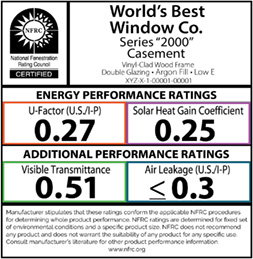Helpful Hints in Selecting Windows

E.E. Cummings once said, “the earth laughs in flowers.”
Now is the perfect time to gaze out your windows to see the great outdoors and all its wonders. When selecting windows for a home there are a few things you need to pay attention to in order to increase your energy efficiency. Windows are less resistant to heat flow compared to the walls, ceiling, and floors in your home meaning they will allow more outward heat flow in the winter and more inward heat flow in the summer. Even though windows typically comprise a small surface area of a home, they can significantly contribute to heat loss and gain in a home. Selecting the most efficient windows for your budget can make a difference in the overall comfort and operation of your home’s heating and cooling system.
Window appearance, required maintenance, how they open, and how they are installed are all important aspects of window selection, but how do you know if they are energy efficient?
The National Fenestration Rating Council (NFRC) maintains a window rating system based on the whole window performance. Look for a label located on the window showing the rating of the window. The label should have the U-factor rating, solar heat gain coefficient rating (SHGC), and visual transmittance (VT) as well as the Energy Star label, if it qualifies.

Windows are not rated by R-value like wall insulation, but by U-factor. The U-factor is the reciprocal of the R-value (R=1/U). The larger the U-factor, the greater the heat flow through the window. That means a lower U-value equals a higher, and better, R-value. The U-factor should read .35 or lower to get the best results.
The solar heat gain coefficient rating (SHGC) relates to how well a product blocks passive solar gain to the interior of the home, which is especially important in heating-dominated climates like ours. This number is expressed between 0 and 1. As the rating gets closer to 1, more solar heat is transmitted into the home. You must be careful not to get the number too high or it will negatively affect the cooling load of your home.
Visible transmittance (VT) refers to the optical properties of the window and does not affect the heating and cooling loads of the home. This number changes based on the type of glazing placed on the window. This number is rated between 0 and 1. As the number gets closer to 1, it lets through more visible light which, in return, can affect how fast colors fade/change on different furniture.
The Energy Star label ensures the window is energy efficient and has met certain U.S. Department of Energy and Environmental Protection Agency energy performance criteria, making it easy for members to make cost-effective decisions.
When selecting windows, do your homework, talk to building contractors, check out literature, and visit websites to get all the correct information.
If you think your windows are the reason for your high energy bills, first make sure they were put in correctly by checking to make sure they are completely insulated around the rough opening of the window. This may require removing some trim, but if you have little to no insulation or the proper caulking needed to seal the frames of the window, this can often cause a drafty feeling around the window openings. Because windows are such a large investment, when it comes to replacement make sure they are installed and insulated properly before purchasing new. If you do need to purchase new windows, follow our advice above and remember to check the label!




